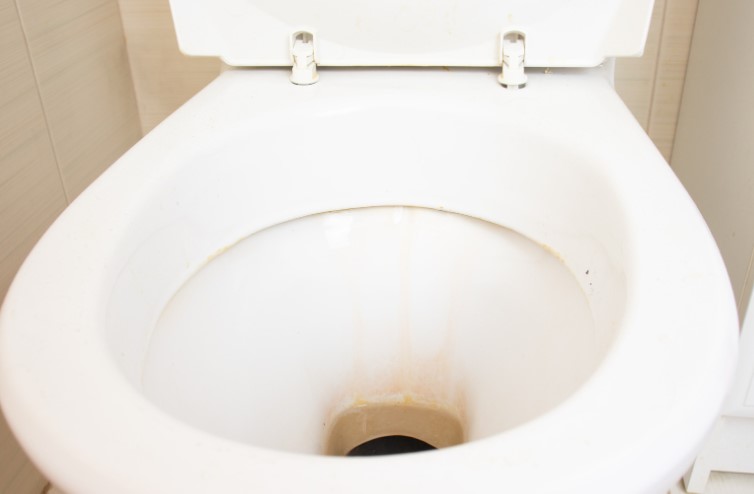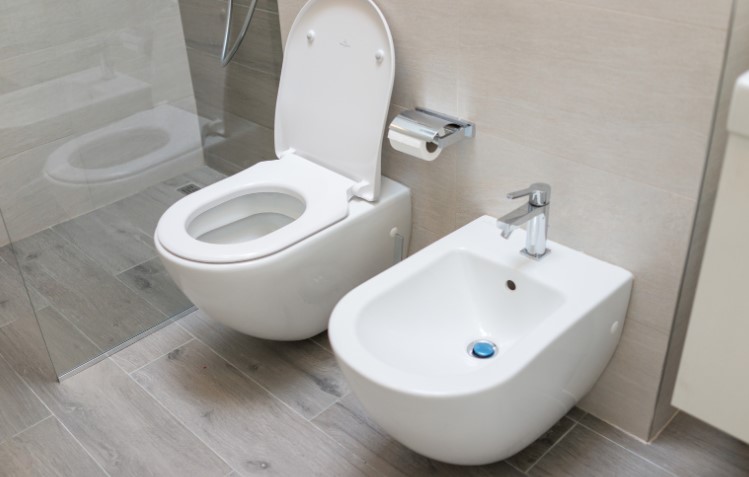Limescale buildup in your toilet, particularly below the waterline, can be an unsightly and frustrating issue. Not only does it affect the appearance of your toilet, but if left untreated, it can also lead to more severe staining and even damage over time.
Understanding how to remove limescale from toilet below waterline is essential for maintaining a clean and hygienic bathroom. This guide will walk you through the causes of limescale formation, the tools and materials you’ll need, and the most effective methods for removing it.
What Causes Limescale to Form Below the Waterline?
Understanding Hard Water
Limescale is a general issue with hard water. Hard water contains high levels of minerals, particularly calcium and magnesium, which can accumulate on surfaces exposed to water over time. These minerals are left behind as the water evaporates, forming the stubborn white or yellowish deposits known as limescale.
Why Below the Waterline?
Limescale tends to form below the waterline in your toilet because this area is constantly exposed to hard water. The mineral-rich water sits in the toilet bowl, slowly depositing calcium and magnesium on the surface.
Over time, these deposits harden and become more challenging to remove, especially since they are often out of sight and more difficult to clean regularly.

What are the Tools and Materials You’ll Need?
What are the Essential Cleaning Supplies?
To effectively remove limescale below the waterline, you’ll need a few key tools and materials:
- Toilet brush: A sturdy brush with firm bristles for scrubbing.
- Pumice stone: Ideal for scraping off tough limescale without damaging the porcelain.
- Vinegar: A natural acid that helps dissolve limescale.
- Citric acid: Another powerful natural cleaner that breaks down mineral deposits.
- Commercial descaler: Available in most supermarkets, designed specifically for removing limescale.
What are the Protective Gear?
While the cleaning agents mentioned are relatively safe, it’s always a good idea to wear gloves to protect your skin, especially when using stronger commercial products. If you’re dealing with particularly tough stains, consider wearing eye protection as well to guard against splashes.
What are the Step-by-Step Guide to Removing Limescale Below the Waterline?
Step 1 – Preparing the Toilet
Initialize by disconnecting the water supply to your toilet. This step will allow you to lower the water level, making it easier to access the limescale below the waterline. After turning off the water, flush the toilet to remove most of the water from the bowl. If it is needed then you can use a cup to scoop out any remaining water, ensuring that the limescale is fully exposed.
Step 2 – Applying the Cleaning Agent
Choose your preferred cleaning agent—vinegar, citric acid, or a commercial descaler. Pour a generous amount directly onto the limescale deposits. If using vinegar or citric acid, you may need to soak some toilet paper in the solution and press it against the limescale to keep it in place.
This method ensures that the cleaning agent remains in contact with the limescale, allowing it to break down the mineral deposits effectively.
Step 3 – Scrubbing the Limescale
After allowing the cleaning agent to sit for the recommended time, use a toilet brush or pumice stone to scrub the limescale. The pumice stone is particularly effective for tough, stubborn deposits. Be gentle yet firm, applying enough pressure to remove the limescale without scratching the porcelain.
Step 4 – Letting the Cleaner Sit
For the best results, let the cleaning agent sit for at least 30 minutes to an hour, depending on the severity of the limescale. This step is crucial as it gives the acid time to break down the mineral deposits, making them easier to scrub away.
Step 5 – Rinse and Repeat if Necessary
Once you’ve scrubbed the limescale, turn the water supply back on and flush the toilet to rinse away the residue. If any limescale remains, you may need to repeat the process. Stubborn deposits might require multiple applications and scrubbing sessions, but persistence will pay off.

What are the Alternative Methods for Stubborn Limescale?
How to Use Baking Soda and Vinegar?
For a more natural approach, you can create a cleaning paste using baking soda and vinegar. Sprinkle the baking soda over the limescale and then pour vinegar over it, allowing the mixture to fizz and bubble. This reaction helps to loosen the limescale, making it easier to scrub away. This method is particularly effective for less severe buildup and is a great eco-friendly option.
How to Use Commercial Limescale Removers?
If natural methods aren’t enough, several powerful commercial limescale removers are available in the UK. These products are designed to dissolve limescale quickly and effectively. When using commercial products, always follow the manufacturer’s instructions carefully and take necessary precautions, such as wearing gloves and ensuring good ventilation.
How to Prevent Limescale Buildup in the Future?
What are The Regular Maintenance Tips?
The best way to deal with limescale is to prevent it from forming in the first place. Regular cleaning is key. Make it a habit to clean your toilet at least once a week, using a toilet cleaner that’s effective against limescale. This routine will help keep the buildup at bay and ensure your toilet stays clean and fresh.
How to Install a Water Softener?
If you live in an area with very hard water, installing a water softener could be a wise investment. Water softeners work by removing the minerals that cause limescale before they enter your home’s plumbing system. While the initial cost may be high, the long-term benefits—such as reduced limescale buildup and prolonged lifespan of appliances—make it a cost-effective solution.
Conclusion
Removing limescale from your toilet below the waterline doesn’t have to be a daunting task. By following the steps outlined in this guide on how to remove limescale from toilet below the waterline, you can effectively eliminate those unsightly deposits and keep your toilet looking pristine.
Remember, regular maintenance is key to preventing limescale buildup in the future. With the right tools and a bit of effort, you can ensure your toilet remains limescale-free and sparkling clean.
FAQs About Limescale Removal
1. Can I use bleach to remove limescale?
Bleach is not effective at removing limescale. While it disinfects and whitens, it doesn’t dissolve the mineral deposits that make up limescale. For best results, stick to acidic cleaners like vinegar or citric acid.
2. Is it safe to use a pumice stone on porcelain?
Yes, a pumice stone is safe for use on porcelain, but it’s important to use it gently to avoid scratching the surface. Always ensure the stone and the area you’re scrubbing are wet to minimize abrasion.
3. How often should I clean below the waterline?
Ideally, you should clean below the waterline every few weeks, especially if you live in a hard water area. Regular cleaning prevents limescale from becoming too stubborn and difficult to remove.
4. What’s the best natural remedy for limescale?
Vinegar is one of the best natural remedies for limescale. Its acidity helps to dissolve the mineral deposits effectively. For tougher stains, a mixture of vinegar and baking soda can work wonders.


0 Comments